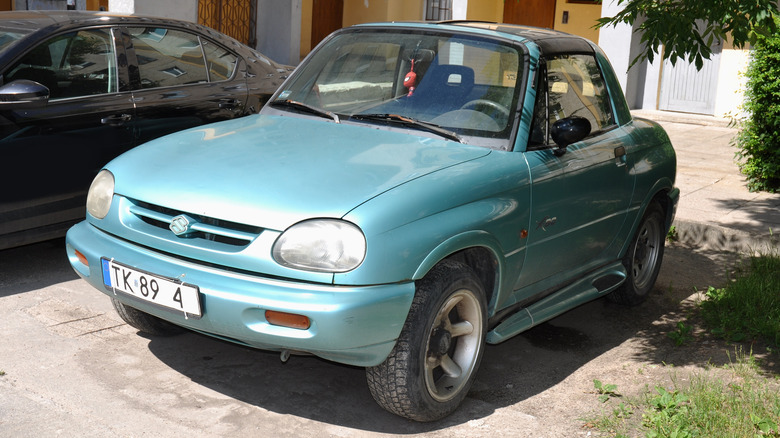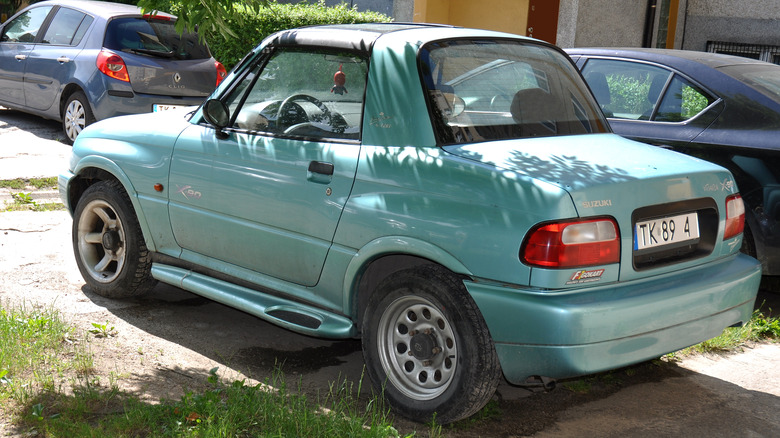This Suzuki Is Regarded As One Of The Worst Vehicles Of The 90s
Japanese automaker Suzuki is no stranger to taking chances with new products. They've not all turned out so well as their first major gamble – from one industry to a completely different industry after decades of dedicated focus. Contrary to popular folklore, the Suzuki brand started life by dabbling in weaving looms instead of motorcycles. It's funny to point out that fellow Japanese carmaker Toyota also began its storied career by patenting the world's first automatic looming machine in 1924. However, Suzuki started earlier in 1909, and it was company founder Michio Suzuki's prerogative to spend the next 30 years developing the world's best silk looming machines before making a relatively major shift.
Suzuki began tinkering with motorized bicycles after World War II, and it entered the world of automobile manufacturing in 1955 with the Suzuki Starlight. The Starlight was a sales success with its four-wheel independent suspension, rack-and-pinion steering, and a front-wheel drivetrain, components that you'd rarely see from a production car in the late 50s.
Suzuki also makes the GSX1300R Hayabusa (heard of it?), the fastest production motorcycle of the 20th century. Named after a ferocious and speedy Japanese peregrine falcon, the 2022 Hayabusa has a top speed of above 186 mph (299 to 303 kph). Based on these facts, Suzuki knows a thing or two about everything with wheels, and it's the reason why we can't get over why Suzuki made what many experts regard as the worst vehicle of the 1990s.
Suzuki X-90: Worst car of the 90s?
The 1990s was a fascinating blur of grunge music, cheesy pop songs, and compact cars like the Honda Civic, Toyota Corolla, and Mitsubishi Lancer. The 90s were also when Japanese automakers were shoehorning bigger and heavier bodies on their compact car platforms, creating crossover SUVs like the Toyota RAV4 and Honda CR-V.
Back then, Suzuki was on top of the heap with the Samurai SUV, and the carmaker sold nearly 120,000 Samurais by mid-1998. It's not hard to see why the Samurai became an instant bestseller. It has a rugged ladder frame chassis (instead of a car-like unibody platform), compact dimensions, and no-nonsense styling, not to mention a bargain $6,550 base price.
However, something unusual happened along the way.
Samurai gets the ax
American non-profit organization Consumer Reports (formerly Consumers Union) stated in 1998 that the Suzuki Samurai (pictured above) performed poorly in its short course avoidance maneuver. In short, the Samurai is prone to tipping over while taking a sharp turn. The Samurai got a "Not Acceptable" rating from Consumer Reports, and news began to spread like wildfire.
Not long after, Samurai sales dropped by 70 percent, and the company started an extensive legal battle with Consumer Reports about the issue. Both companies eventually settled the case in 2004, but American consumers will never look at the Samurai the same way again.
Enter the Suzuki X-90
This circle of events led Suzuki in developing the X-90, the Samurai's predecessor. The X-90 has a similar ladder frame chassis derived from the two-door Sidekick (or Vitara in other markets). Still, Suzuki gave its durable chassis an absurdly quirky body, a truck-like five-speed gearbox, and an absurd $16,288 price tag – more than double the MSRP of a Samurai. From these facts alone, the numbers are unfavorable to the X-90, and we haven't gotten to the worst part yet.
The X-90 is a two-door and two-seat SUV with a removable T-section roof. It sounds brilliant when you describe it that way, but why does it look like the cross between a Mazda MX-5 and Suzuki's own Mighty Boy coupe-utility Kei car after a long night of cheap whiskey and cold pizza?
It also has an out-of-place rear spoiler, and we're talking about a car that can supposedly go farther when the tarmac ends, so what's the point? Except, the X-90 can't go very far over rugged terrain, either, since it has street-spec tires and a questionably low ride height.
Compounding the stiff chassis are strut suspension in the front, a coil-sprung solid rear axle, and rigid springs/dampers to give the X-90 the ride comfort of a tuk-tuk or rickshaw. The X-90 can't go off-road, and it's not suitable for the street, either.
Redeeming factors
It's not all bad news. The Suzuki X-90 has modern safety features like dual front airbags, four-wheel anti-lock brakes (ABS), side-impact beams, and a full-size spare tire in the trunk. It may be double the price of the Samurai, but the interior has comfy seats and more than enough room for your legs, elbows, and head to move around.
The Suzuki X-90 made good use of its 1.6-liter SOHC four-cylinder engine with 95 horsepower and a 4.63:1 final drive ratio. It may not sound much, but it can go from zero to 60 mph in 10.8 seconds and a 94 mph top speed, said Car and Driver, but you'll need to live with a choppy ride and deafening tire roar while doing so.
But then again, it doesn't have a back seat, and you're better off leaving the removable T-tops at home since there's barely enough room for them in the boot. The Suzuki X-90 is a love-it or hate-it affair, but its astronomical base price is the final nail in the coffin.
In this modern world where the fourth-gen Suzuki Jimny is lording sales charts in Europe while capturing the world's imagination, we reckon the X-90 is the right vehicle at the wrong time. Given its robust chassis and confusing styling, the X-90 is the type of car that grows on you the longer you stare. Charm can only get you so far, and Suzuki pulled the plug on the X-90 only two years after its initial 1995 release as proof of the fact.



